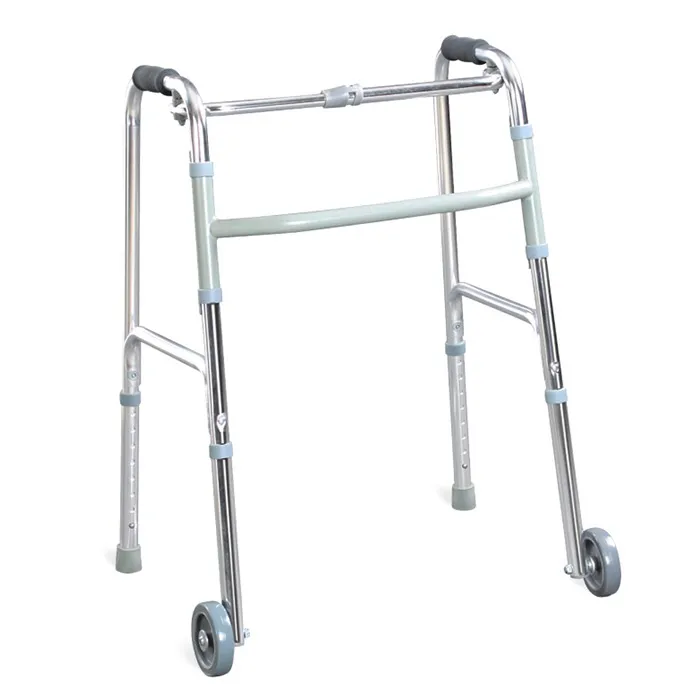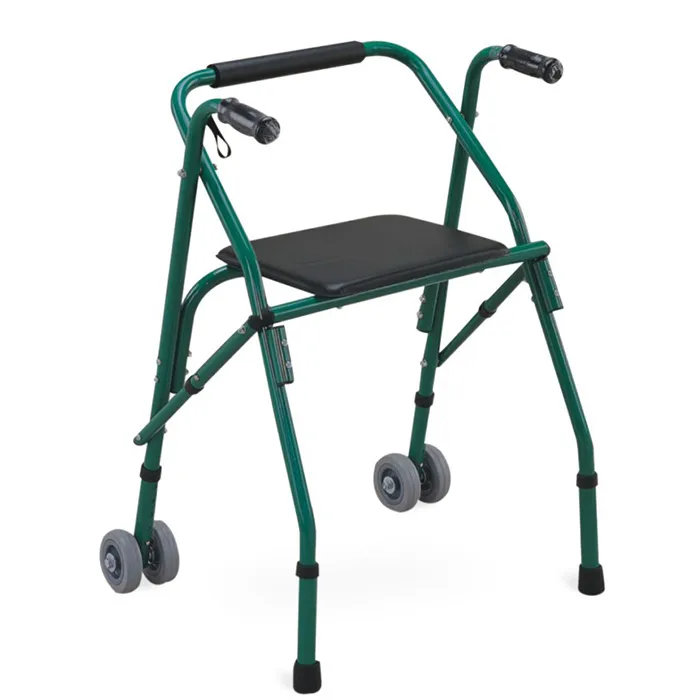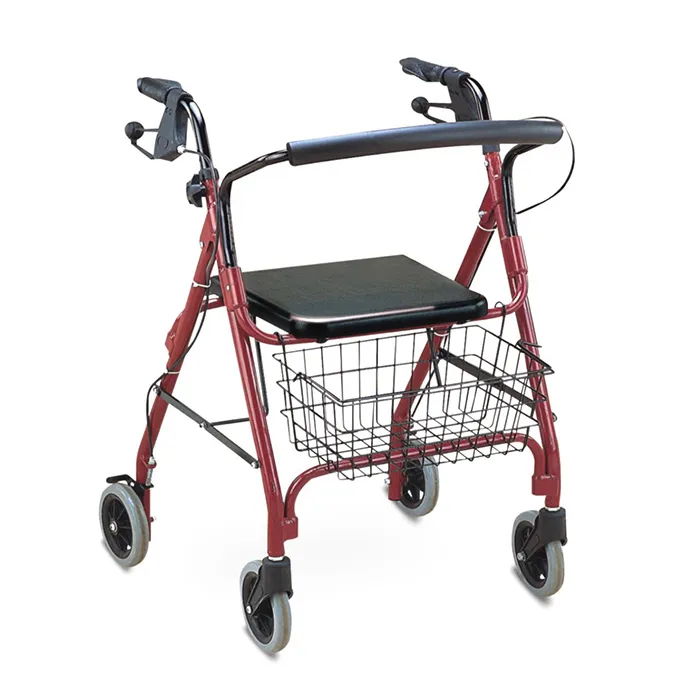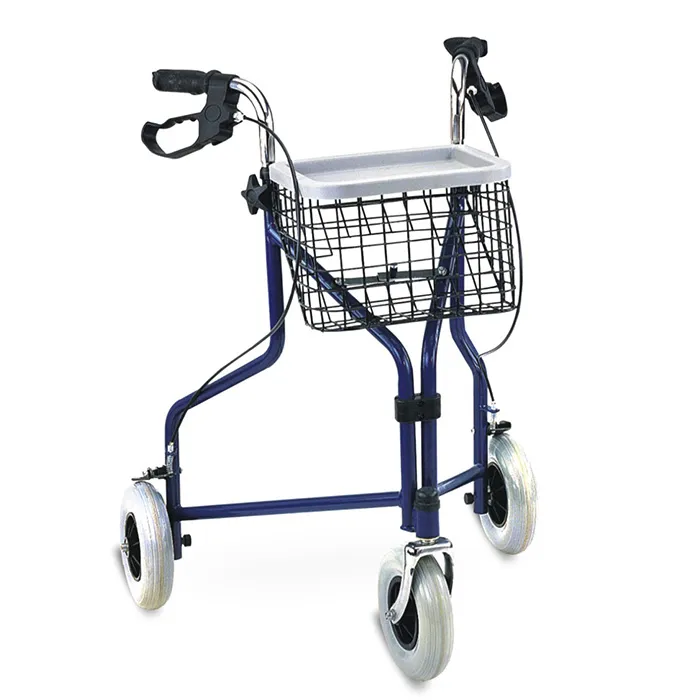In order to help the elderly improve their mobility, a variety of walking aids have appeared on the market. Among them, walking frame with wheels has become one of the commonly used aids for the elderly due to its excellent stability, support and convenience. So, is walking frame with wheels safe for the elderly? Are there any potential risks when using walking frame with wheels?
This article will analyze this issue from multiple angles to help everyone better understand the impact of walking aid with wheels on the safety of use by the elderly.

What is walking frame with wheels?
A walking frame with wheels is a gait aid that provides stable support through four support points, each with wheels. Unlike traditional four-legged walkers, walking frames with wheels have higher flexibility and ease of operation, which can help the elderly walk more easily indoors and outdoors. Depending on the design, walking frames with wheels are usually of two main types:
· Walkers with front wheels: This type of walker is equipped with two wheels in the front and fixed rubber pads or non-slip feet in the back. Users can push the front wheels, while the rear wheels provide stable support.
· Four-wheeled walker: This type of walker has four wheels as support points and is often equipped with a brake system, which can help users push it more easily. It is especially suitable for elderly people who need greater support and stability.
Walking aid with wheels is designed to provide a stable support platform, allowing users to walk more easily while reducing the risk of falling due to instability.
What are the advantages of walking frame with wheels?
Advantages of walking frame with wheels:
1. Higher stability and support
2. Easy to operate and adaptable
3. Improved freedom of movement
4. Additional features: seat and storage bag
1. Higher stability and support
Compared with traditional crutches or walking frames without wheels, walking frames with wheels provide more support points, which makes them have obvious advantages in stability. The design of four support points greatly improves the sense of balance of the elderly when walking and reduces the risk of tilting. Especially for the elderly with unstable gait or weak physical strength, walking aid with wheels can provide better support.
2. Easy to operate and adaptable
Walking aid with wheels has good flexibility. Users do not need to lift it to propel it forward with every step like traditional walkers, but can move it by gently pushing it. This design is particularly suitable for elderly people with weak arm strength or who need greater support, so that they can reduce physical exertion and relieve joint burden when walking.
3. Improve freedom of movement
Walking frame with wheels is particularly suitable for elderly people who need to move in different scenarios. For example, it can adapt to indoor, outdoor and slightly undulating ground environments, helping the elderly to gain greater freedom of movement when walking. The wheel design makes the walker more stable in environments such as tiled floors, smooth floors, and wooden floors.
4. Additional functions: seats and storage bags
Many walking aids with wheels are equipped with additional functions such as seats and storage bags, which can provide more convenience for the elderly. For example, when the elderly are tired, they can rest on the seat of the walker at any time; and the storage bag can help carry small items such as water bottles, medicines, mobile phones, etc., which increases the versatility of use.

Is walking aid with wheels safe?
1. Wheel design and stability
The design of the wheel is a key factor affecting the safety of walking aid with wheels. If the wheel is too small, the material is poor or the quality is unstable, it may cause the walker to become unstable, thus affecting the safety of the user. Therefore, when choosing a walking aid with wheels, you need to pay attention to the material, size and design of the wheel. High-quality wheels should have good anti-slip properties and can roll stably on different surfaces without slipping due to uneven or slippery environments.
In addition, the walking frame with wheels should have a certain height adjustment function so that it can be adjusted to a suitable height according to the height of the elderly of different heights, so as to avoid improper posture or instability caused by improper use.
2. Safety of the brake system
Many walking frames with wheels are equipped with a brake system, which allows users to more easily brake the walker when they need to stop, thereby increasing safety during use. The safety and reliability of the brake system are crucial. Walkers with inflexible brakes or easy loosening may cause users to be unable to brake in time while walking, increasing the risk of falling. Therefore, choosing a walker with a high-quality braking system and ensuring that the brake operation is simple and effective is the key to ensuring the safety of the elderly.
3. Anti-slip function
Anti-slip design is another important factor in the safety of walking aid with wheels. Whether on wet or uneven ground, the anti-slip design can effectively prevent the wheels from slipping, thereby reducing the risk of falling. High-quality walking aid with wheels are usually equipped with specially designed anti-slip wheels or tires, so that it can maintain stable support on all kinds of ground.
4. Ability to adapt to different ground surfaces
The stability and safety of walking aid with wheels also depends on whether it can adapt to different ground conditions. The design of high-quality walkers should not only take into account flat ground, but also the use in complex environments such as uneven and slippery ground outdoors. Walking frames with wheels with good adaptability are usually equipped with larger wheels, sturdy frames and wear-resistant tires, which can reduce shaking and instability on uneven ground and provide a safer walking experience.
5. Auxiliary functions and safety
The design of modern walking aid with wheels pays more and more attention to humanized functions. Many products have added auxiliary designs such as seats and storage bags, which provide more convenience for the elderly. However, these additional functions may also affect the stability and safety of the walker. For example, a too loose seat design or an unstable storage bag may increase the risk of falling. To ensure safety, you should pay attention to the overall structure of the walker when choosing it, and ensure that the additional functions do not hinder the user's walking balance.

What are the risks of using walking aid with wheels?
Risks of using walking aid with wheels:
1. Falls caused by improper use
2. Slippage caused by poor wheel quality
3. Failure of the brake system
Although walking aid with wheels have significant advantages in providing stable support and flexibility, they may also bring some potential safety risks.
1. Falls caused by improper use
If the elderly do not use walking aid with wheels correctly or do not pay attention to obstacles in front of them when walking, they may fall. For example, when using walking aid with wheels, if the brakes are not used in time, the walker may suddenly slide, causing the user to lose balance. In addition, during the walking process, the elderly may not pay enough attention to objects under their feet or uneven ground, which may cause falls.
2. Slipping caused by poor wheel quality
The wheel quality of the walking aid with wheels directly affects the stability of walking. If the wheels are of poor quality or improperly designed, they may slip in wet, sandy or muddy environments, increasing the risk of falling. Therefore, when choosing a walking aid with wheels, special attention should be paid to the material and design of the wheels to ensure that they have sufficient friction in different environments to prevent slipping.
3. Failure of the brake system
The failure or inflexibility of the brake system is a major hidden danger of walking aid with wheels. If the brakes do not take effect in time, the walker may continue to slide when it stops, causing the user to lose balance or even fall. Therefore, when using walking aid with wheels, the elderly must learn to operate the brakes correctly and ensure that the brake system is in normal condition.

How to ensure the safety of walking aid with wheels?
1. Choose the right walker
When choosing a walking aid with wheels, make sure it is suitable for the specific needs of the elderly. For example, the size, quality, design of the wheels, and whether the brake system is reliable all require special attention. In addition, factors such as whether the height of the walker is adjustable, whether the frame is stable, and whether it is easy to operate should also be taken into account.
2. Check the walker regularly
When using walking aid with wheels, the elderly and their families should regularly check whether the functions of the walker are normal, especially the wear of the brake system and wheels. If there is any damage or abnormality, it should be repaired or replaced in time to ensure that it continues to provide reliable support and stability.
3. Educate the elderly on the correct use method
In order to ensure the safe use of walking aid with wheels, the elderly should receive some basic operation training to understand how to use the brakes correctly, how to walk in different environments, and how to avoid common usage errors. Family members or caregivers should guide the elderly to ensure that they can use the walker correctly and safely.
What Hospital Furniture Does Yikang Medical Supply?
At Yikang Medical, we specialize in a wide range of hospital furniture and rehabilitation equipment. Our product line includes hospital beds, nursing beds, electric wheelchairs, manual wheelchairs, bath chairs, toilet chairs, and walking aids. As a China-based supplier and factory, we offer low price solutions with high quality standards. Whether you need customized designs or bulk purchasing options, we provide fast delivery and competitive quotes for global buyers.

